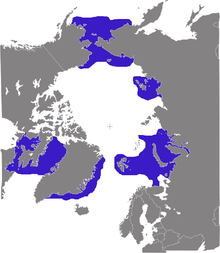Walrus
A walrus (Odobenus rosmarus) is a marine mammal,[2] the only species of the family Odobenidae, which is one of the three pinniped families. They live in the cold northern seas of the Arctic Ocean around North America and Europe.
| Odobenidae Odobenus Odobenus rosmarus | |
|---|---|

| |
| Scientific classification | |
| Kingdom: | |
| Phylum: | |
| Class: | |
| Order: | |
| Suborder: | |
| Superfamily: | |
| Family: | Odobenidae Allen, 1880
|
| Genus: | Odobenus Brisson, 1762
|
| Species: | O. rosmarus
|
| Binomial name | |
| Odobenus rosmarus (Linnaeus, 1758)
| |
| Subspecies | |
|
O. rosmarus rosmarus | |

| |
| Distribution of Walrus | |
Description
changeWalruses have lots of things similar to true seals and eared seals. Like true seals, they just have a hole for an ear - not ear flaps. Like eared seals, they can rotate their back flippers forward to walk on land. Like both true seals and eared seals, they are very good swimmers and divers. However, walruses do have some features that neither true seals nor eared seals have.
The most famous thing about walruses are their tusks. Even though they are called tusks, they are actually teeth growing out of their mouth, a bit like the narwhal. The tusks grow for about 15 years before they reach their full length, which is about 102 cm (40 in) for males and 76 cm (30 in) for females.
Both the male and female walrus grow tusks. They can use them to protect themselves from polar bears and killer whales and use them when they eat. When they eat bigger preys such as seals and small whales, they first tear them apart with their tusks to make them easier to eat. Another important use of a walrus's tusks is to pull itself out onto the ice. Pushing its tusks into the ice, the walrus gets extra help hauling its huge body out of the sea. This is probably how walruses got their family name Odobenidae, which comes from Greek words meaning "one that walks with teeth". They do not walk with their teeth, but it can look as if they do when they pull themselves out of the water. Their tusks can also be used to cut holes in the ice.[3] Tusks are slightly longer and thicker among males, who use them for fighting, dominance and display; the strongest males with the largest tusks typically dominate social groups. Tusks are also used to form and maintain holes in the ice and aid the walrus in climbing out of water onto ice.[4]
Walruses are very big, even compared to big male sea lions. When they are all grown up, they can weigh more than 1,400 kg (3,086 lb). The walruses that live in the Atlantic Ocean are a little smaller than the ones in the Pacific Ocean. Both kinds like to stay in the cold north. With all their blubber, which can be as much as 6 in (15 cm) thick, they are very comfortable in icy water.
Features
changeWalruses are usually brown, but walruses can change colour depending on how warm they are. They are usually different kinds of brown, but as they get warmer, their skin can turn pink. This is because as they get warmer, blood rushes to the skin to try to cool it.
The walrus has an air sac under its throat which acts like a flotation bubble and allows it to bob vertically in the water while sleeping.
The males have a large penis bone, up to 63 cm (25 in) in length, the largest of any land mammal, both in absolute size and relative to body size.[5]
References
change- ↑ Seal Specialist Group (1996). Odobenus rosmarus. 2006 IUCN Red List of Threatened Species. IUCN 2006. Retrieved on 12 May 2006.
- ↑ Wozencraft W.C. (2005). Wilson D.E. and Reeder D.M. (ed.). Mammal species of the world (3rd ed.). Johns Hopkins University Press. ISBN 0-8018-8221-4.
- ↑ Berta A. and Sumich J.L. (1999). Marine mammals: evolutionary biology. San Diego, CA: Academic Press. pp. 494 pp.
- ↑ Fay F.H. (1982). "Ecology and biology of the Pacific walrus, Odobenus rosmarus divergens". United States Department of the Interior, Fish and Wildlife Service.
- ↑ Fay F.H. (1985). "Odobenus rosmarus". Odobenus Rosmarus. Mammalian Species. 238 (238): 1–7. doi:10.2307/3503810. JSTOR 3503810.
